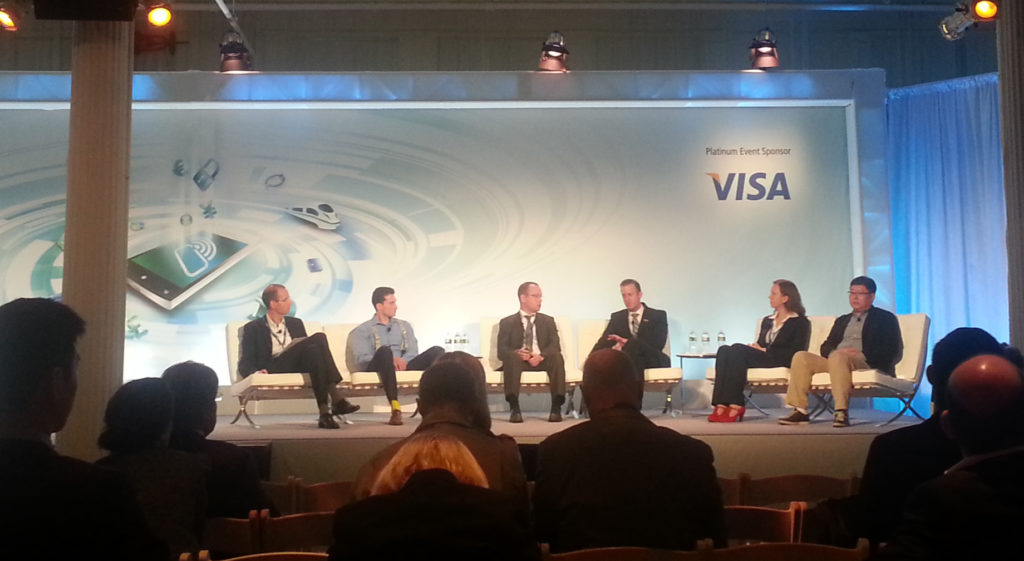Today in New York City, the NFC & Mobile Money Summit kicked off with many talks of interest including a panel on the state of NFC. Organized by the GSMA, the same organization behind the annual Mobile World Congress, the event featured a couple dozen exhibitors as well as an engaging conference track.
The aforementioned NFC panel was well-attended, and featured speakers from three continents discussing their thoughts on where things stand with NFC. The bottom line, not to spoil the ending of this recap, is that we are still in the very early stages of the technology. All but one of the panelists was primarily payments-focused, and there’s a fair case to be made that this is a grounded perspective. But no one could boast enormous NFC adoption and a mature state of the technology just yet.
The first speaker was J.H. Kah of SK Planet, which is a recent spinoff of South Korea’s SK Telecom. It operates its own app store and payment infrastructure. It focuses on developing capabilities for mobile credit cards, mobile debit card and mobile transportation card. That said, he did acknowledge that in order for payments to take off, NFC had to be better integrated into people’s lives. SK Planet is working hard on the engineering challenges in particular of putting the secure element for NFC payments inside carrier-issued SIM cards, such that carriers can control mobile payments.
From Norway’s Telenor, Viktoria Erngard introduced the audience to the carrier’s new Valyou platform. The Valyou platform is a contactless payments mechanism launching in Oslo this week. Telenor ultimately hopes to leverage this sort of technology worldwide to their 150 million customers. Valyou is a mobile wallet at heart, tied at launch to the major Norwegian bank DNB, with more such banks to follow in the near future. Ms. Erngard urged the audience to have patience, as customer uptake of this technology worldwide may be slower than expected.
Mikhail Damiani of Blue Bite brought a marketing perspective into the mix. His company has been involved in many NFC-powered out-of-home campaigns. They did a Samsung campaign where device users could tap a bus shelter sign to download a free song or eBook. For the latest Star Trek movie, users could tap a poster in the movie theater and download longer-form exclusive trailer. In another interesting execution, this time for Toyota, users who tapped out-of-home signage in malls could launch an HTML5-based augmented reality experience.
Blue Bite has even attempted to upgrade the advertising experience of airport security bins. NFC tap points in these bins during one campaign launched ads for the Clear security program. They also rely on what they call an “mTag”. This is a combination of an NFC sticker with a QR Code, to accommodate those comfortable with either. As a baseline, Mr. Damiani recommends that for any NFC-based campaign, the best practice is for the payoff to be relevant to the context of the ad, valuable to the user, and exclusive.
The last speaker was Maxim Sidorov from Russian MNO VimpelCom. In June 2013, VimpelCom launched a PayPass pilot in partnership with AlphaBank and MasterCard. They are also rolling out a SIM-card based pilot of a mobile solution for the Moscow Metro. Their view of the NFC ecosystem encompasses SIM cards, handsets, POS terminals and payment sources. It is a very SIM-card-based, payments-centric perspective on NFC. Mr. Sidorov directly addressed the ongoing divide between telecoms and device-makers over where to store secure payment data for NFC transactions. He advocated for the carriers to manage this via the SIM card, since they know how to drive mass scale adoption of technologies and have the power to adopt and enforce standards. He lamented that competition between these points of view could damage the whole NFC space and delay wide adoption.
During the panel discussion, everyone agreed that their programs were all early-stage and there’s no big consumer uptake yet. Even Blue Bite acknowledged that in their “mTag”-based out-of-home signage, only 30-40% of interactions were NFC rather than QR-code based.
Interestingly, considering mobile and smartphones are the focus of the event, it was 74 minutes into the 90-minute session that Apple was first mentioned. The sense on the panel was that Apple hasn’t adopted NFC yet because consumers are not yet asking for it. One theory is that as transit systems adopt contactless payments, consumer demand may rise.
And thus, in summary, the space continues to inch along. There are lots of interesting innovations brewing, but the inflection point of consumer demand for NFC has not yet arrived. That said, it is exciting to think about all the possibilities that lie ahead once adoption does begin to scale.
